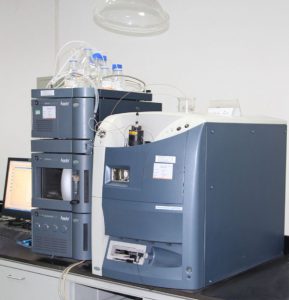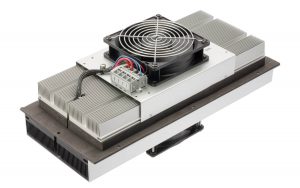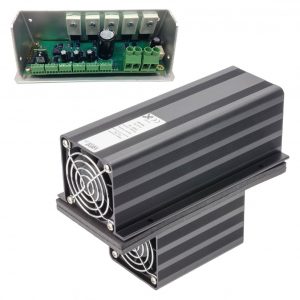
Storage cooling technology is critical in medical environments
By Andrew Dereka, product director, Laird Thermal Systems
Electronics Thermal management Medical cooling cooling enclosures enclosures medical medical Storage StorageIndustries such as biotech use liquid chromatography equipment to break down the chemical composition of complex liquids
Liquid chromatography equipment and other analytical instrumentation are used in a variety of industries for sample analysis. Samples to be tested are typically stored in a refrigerator, and then moved to a temperature-controlled sample storage compartment located near the test equipment while awaiting analysis.

Liquid-chromatography-mass-spectrometry-equipment.
Background
Industries such as biotech, pharmaceutical and food science use liquid chromatography equipment to break down the chemical composition of complex liquids and determine their makeup on an elemental basis by relative proportions. The process normally operates by passing small amounts of liquid through a stationary phase. These small samples are analyzed one at a time, requiring much testing to increase the accuracy and to accelerate the time frame for completing the analysis. Liquid chromatography is often used in R & D laboratories for product development or for reverse engineering the composition of a given liquid. In addition to industry, governments and universities also make use of liquid chromatography equipment for their research.
Liquid chromatography systems have a high throughput and utilize add-on sample storage chambers to control the specific temperature of the samples prior to separation. Temperature control of these samples is important, as the temperature influences the interaction between the components within the liquid sample and the adsorbents. The liquid samples generally require cooling, down to as low as 4°C (39°F). However, some samples may need to be heated as high as 40°C (104°F). Each storage chamber requires a system to provide cooling or heating, as needed.
Design Objectives for Storage Chamber Cooling
Given the small sample sizes used in liquid chromatography, the storage chambers are generally small units that are stacked on top of one another to save bench space. Stacking the storage chambers presents some challenges because the air cannot flow vertically through the chambers, it can only move horizontally through the units, usually from front to back. This leaves limited access to airflow circulation.
The space constraints for the storage chambers require that the thermal solution be efficient. Cooling the compartment and rejecting air out of the system necessitate effective heat exchanger mechanisms operating in a limited space. Insulating the compartment properly is also important to minimize passive losses. Finally, cooling the storage chambers must be done at a reasonable cost with minimal maintenance. TEA’s generally require no maintenance, only cleaning dust built up on heat sinks with compressed air.

PowerCool assembly.
Thermoelectric assemblies (TEAs) or Peltier module cooler assemblies are an advantageous technology to use for this application. They can provide both cooling and heating, maintaining the control temperature of the storage chamber between 4 and 40°C in ambient temperatures of 23 to 30°C. They offer compact form factors to accommodate the tight geometric space constraints. Operation is either 12 or 24 Vdc, which is helpful with universal power supply when shipping products to multiple regions. Heat load requirements can range from 25 to more than 100 Watts.
TEAs contain thermoelectric modules (TEMs) or thermoelectric coolers, which are solid-state Peltier heat pumps. Heat transfer mechanisms are used to absorb heat from one side and dissipate heat thru the other side. Usually exhausting into air environment. A temperature controller (TC) regulates the temperature of the TEA, and thereby the temperature within the storage chamber, by adjusting the output of its power supply. The solid-state construction of the TEAs provides both long life cycles and low maintenance operation.
Challenges and Opportunities in Storage Chamber Cooling
There are three big challenges in storage chamber temperature control. The first is proper insulation of the storage chamber itself. Poorly insulated chambers will make any thermal solution less effective due to passive heat losses.
The second challenge is the heating and cooling capacity of the TEA. If the chamber is poorly insulated, then the TEA has to work harder and it will take longer to reach its cooling capacity. Also, the space limitations inside the chamber can affect the heat pumping capacity and time to cool down as well.

Tunnel Series with SR-54 controller.
The third challenge is managing condensation. As the temperature drops below its dew point, moisture can form on the cold surfaces and seep into the TEM cavity, causing it or other components to deteriorate and fail. This is a good reason to have properly designed insulation materials.
These challenges require that there be a robust solution at the TEA level to keep condensation out of the TEA cavity to provide moisture protection. Incorporating features such as gasket sealing, or even double barrier protection, are some ways to avoid condensation from penetrating into the cavity. One item that is not an issue in cooling of the storage chambers is precise temperature control. Control to within ±1°C is sufficient for this application.
Many opportunities exist in the analytical instrumentation market. In addition to liquid chromatography, mass spectrometers, incubators and protein analyzers are other applications that may require sample storage cooling.
Finally, TEAs do wear out, providing an opportunity in the service and replacement parts business. Some units fail in operation after one year in the field. As they try to maintain the 4°C chamber temperature, condensation forms on the cold side and penetrates the TEA cavity, getting in contact with a sensor or an over-temperature thermostat switch, which can cause the unit to fail. Liquid chromatography equipment can cost tens of thousands to a hundred thousand dollars for a single unit, while the TEAs in the storage chambers cost only a couple hundred dollars. Typically, a TEA that fails is not repairable and is simply replaced in the field.
Conclusions
The use of thermoelectric or peltier module assemblies are ideal for sample storage compartments in analytical instrumentation. These units provide a compact thermal solution that is efficient, stable and reliable with low total cost-of-ownership including low to no maintenance.
